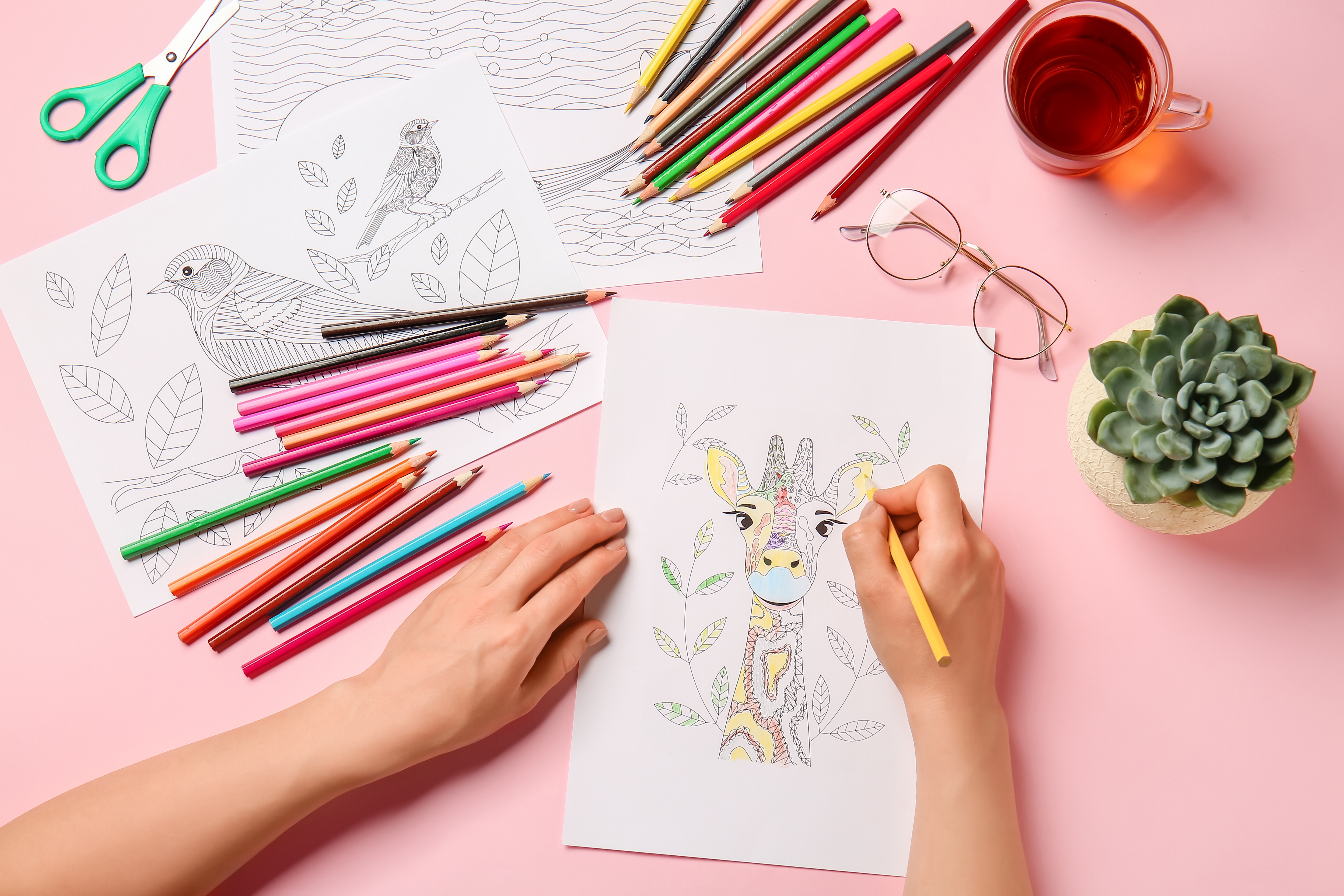In a world that often feels hectic and overwhelming, finding simple, effective ways to boost mental health and mindfulness is more important than ever. Colouring, a pastime many of us cherished as children, has resurfaced as a popular tool for adults seeking a creative outlet for relaxation and stress relief. Let's explore seven benefits of colouring that can help enhance your mental well-being and mindfulness.
Jump to:
- Reduces Stress and Anxiety
- Enhances Mindfulness
- Improves Mood and Mental Health
- Boosts Focus and Concentration
- Offers a Gateway to Meditation and Relaxation
- Enhances Cognitive and Motor Skills
- Provides a Healthy Emotional Outlet
- Frequently Asked Questions About Colouring For Mental Health and Mindfulness
- Study Art Therapy for £29
What is Mindful Colouring for Adults?
Mindful colouring involves being fully present with the colouring activity, noticing the sensations of the crayon in your hand, or the pattern coming to life as you fill in the design. It is a practice that can enhance your awareness and sensory focus, which is a cornerstone of mindfulness training.
Recommended for you!
Best SellersWhy is Colouring so Good for You?
1. Reduces Stress and Anxiety
Colouring has a powerful ability to reduce stress and anxiety. This benefit arises from the way colouring captivates the mind, restricting its capacity to dwell on distressing thoughts. This is particularly true when engaging with intricate patterns such as mandalas. These designs demand a level of focus that naturally diverts your attention from daily stresses, fostering a tranquil state of mind.
The simple act of choosing colours and filling in spaces allows a meditative escape, promoting calmness and reducing the physiological markers of stress, such as elevated heart rate and blood pressure.
2. Enhances Mindfulness
The act of colouring is inherently mindful, pulling your focus into the present moment, much like mindfulness meditation. As you select colours and navigate the boundaries of the artwork, you become fully engaged with the task at hand. This intense focus on the present activity helps to ground you, easing restlessness and reducing impatience.
The sensory experience of the pencils moving across the paper and the visual satisfaction of colours filling blank spaces help reinforce this state of mindfulness, making colouring a powerful daily mindfulness practice.
3. Improves Mood and Mental Health
Colouring has positive effects on the brain's chemistry. Engaging in this creative outlet releases dopamine, known as the 'feel-good' hormone, which can elevate mood and bring about feelings of happiness.
This chemical change reduces feelings of sadness and depression, providing an effective therapeutic tool for improving mental health through a sense of accomplishment and satisfaction.
4. Boosts Focus and Concentration
The requirement for focused attention while colouring engages the frontal lobe of the brain, which is responsible for problem-solving and decision-making. This mental engagement helps improve concentration and attention to detail, making colouring an excellent exercise for the brain.
Regular colouring sessions can help enhance cognitive flexibility and increase the brain’s ability to process information, benefiting daily tasks and overall mental acuity.
5. Offers a Gateway to Meditation and Relaxation
Colouring can be incredibly soothing, with the repetitive motion of pencils on paper providing a physical rhythm that encourages relaxation. This rhythmic action can have a meditative quality, helping to soothe the mind and body, particularly in the evenings as a way to wind down before bedtime.
For those struggling with insomnia or anxiety, colouring can be a beneficial pre-sleep ritual that decreases anxiety and promotes a deeper, more restorative sleep.
6. Enhances Cognitive and Motor Skills
The act of colouring engages multiple brain processes, including vision and fine motor skills, which are essential for hand-eye coordination. Staying within the lines and choosing colours thoughtfully helps enhance precision and dexterity.
The cognitive effort involved in making artistic decisions enhances cognitive abilities, which can translate into improved performance in other areas requiring fine motor skills and cognitive precision.
7. Provides a Healthy Emotional Outlet
For many, expressing emotions verbally can be challenging. Colouring offers a non-verbal outlet for emotional expression, allowing feelings to be channelled through artistic choices. The intensity or delicacy of strokes and the choice of colours can reflect your emotional state, providing a safe space for emotional release.
This form of expression can be particularly therapeutic for those who need an alternative way to deal with complex feelings, helping to clear emotional blockages and improve emotional well-being.

Frequently Asked Questions About Colouring For Mental Health and Mindfulness
Does colouring help with PTSD?
Colouring can be particularly beneficial for people with Post-Traumatic Stress Disorder (PTSD). It provides a form of distraction that can help manage intrusive thoughts and flashbacks. The structured nature of colouring allows individuals with PTSD to focus on the present task, which can be calming and reduce the symptoms of anxiety and hyperarousal often associated with PTSD.
Can colouring help anxiety?
Colouring has been shown to significantly decrease anxiety. It provides a mindful break from daily stresses and creates a meditative state that many find calming. The focus required to colour intricate patterns can divert attention away from anxious thoughts and channel them into a productive and soothing activity.
Is colouring good for memory loss?
Colouring may provide some benefits for those experiencing memory loss by stimulating areas of the brain related to fine motor skills and cognition. While it is not a cure for memory loss, the activity can help maintain brain function and encourage mindfulness, which in itself can help with cognitive recall.
Does colouring help with overthinking?
Colouring can be effective in reducing overthinking. By focusing on the present activity, individuals can escape from continuous cycles of repetitive thoughts, which is a common characteristic of overthinking. This practice helps bring attention to the moment, reducing the tendency to ruminate on past or future worries.
Why is colouring good for mindfulness?
Colouring aligns closely with mindfulness because it involves focusing on the present task, paying attention to colours and shapes, and observing bodily sensations. This focus and attention help centre the mind, reducing scattered thoughts and promoting tranquillity.
Is colouring a cognitive activity?
Colouring is a cognitive activity. It involves problem-solving (choosing colours, deciding how to blend or shade), fine motor skills and hand-eye coordination, and memory (recalling specific techniques or preferences), all of which engage different areas of the brain.
Is adult colouring a hobby?
For many people, adult colouring has become a hobby. It provides a creative outlet and a therapeutic way to relax. Like any hobby, it offers a break from routine, stimulates the brain, and gives a sense of accomplishment.
Does colouring help with ADHD?
Colouring can be particularly beneficial for people with Attention Deficit Hyperactivity Disorder (ADHD), as it provides a structured creative outlet and helps to increase attention span and focus.
Is colouring a form of meditation?
The repetitive strokes and focusing on simple, repetitive tasks in colouring can parallel the benefits of traditional meditation, helping your mind settle and creating a calming effect.
Can colouring help with depression?
Colouring can serve as a therapeutic activity that may help reduce symptoms of depression by providing a purposeful task that can improve your mood and create a sense of accomplishment.
Recommended for you!
Best SellersStudy Art Therapy for £29
Art therapy offers a unique pathway to emotional healing and self-discovery, enabling you to explore your creativity as a powerful therapeutic tool.
If you're ready to hone your artistic skills, our Art Therapy Diploma Course is the perfect starting point. This course is designed to deepen your understanding of how art can promote healing and personal growth. For a limited time, we're offering this course at a special discounted rate of just £29!














